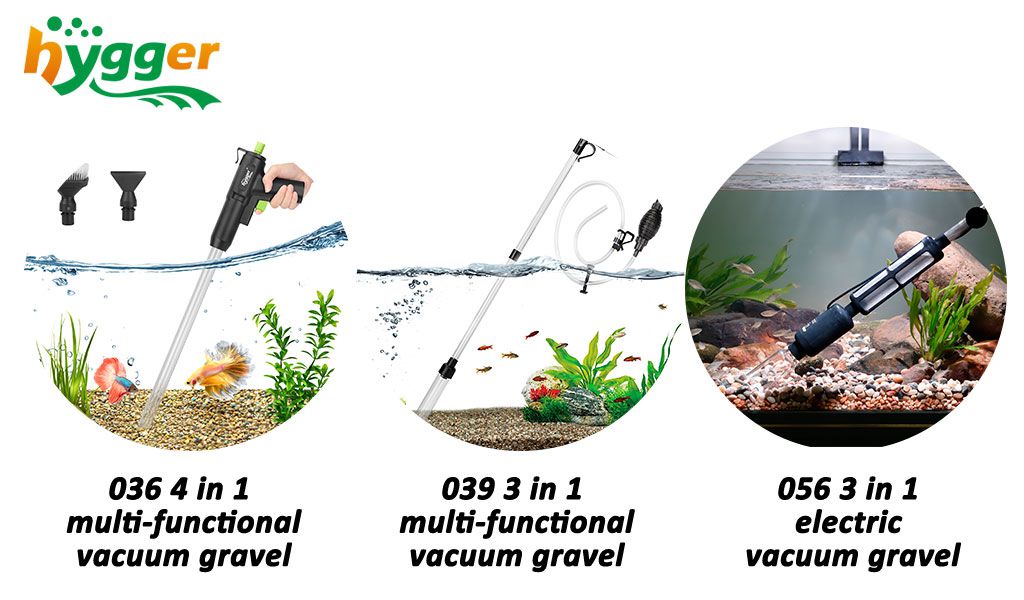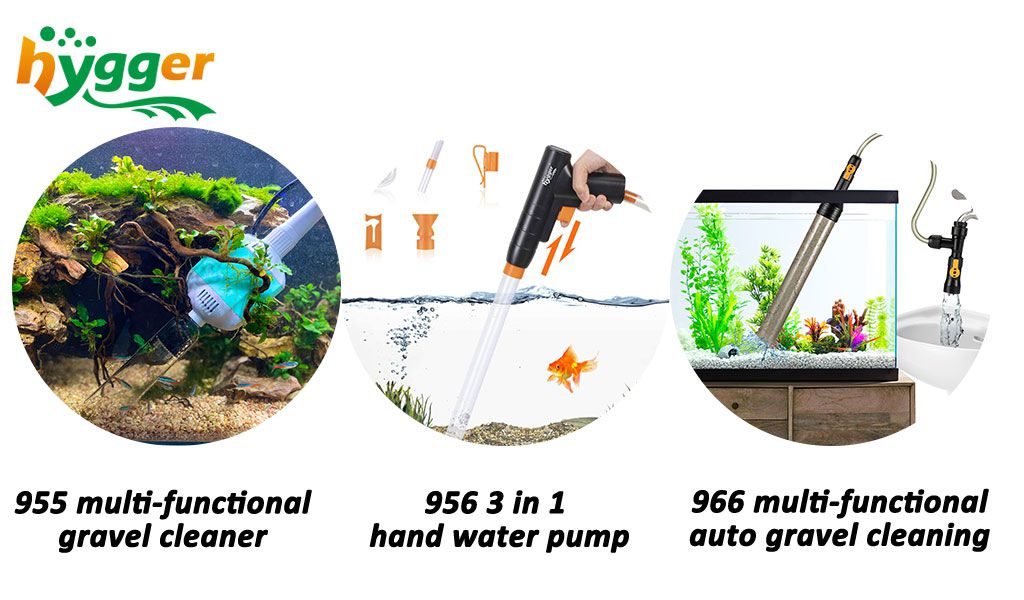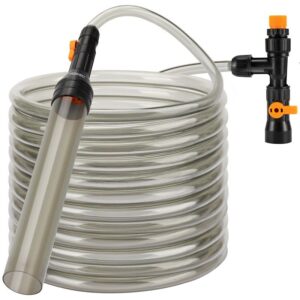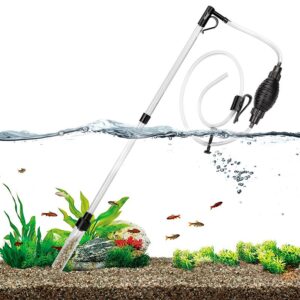Regular water changes and aquarium cleaning gives guarantee great water conditions and a comfortable living environment. While cleaning, a gravel vacuum will help you a lot, which makes sense in cleaning substrate and changing water. Today’s article will cover several aquarium gravel vacuums and share some tips about choosing the best gravel vacuuming and how to use a gravel vacuum. Rant over, let’s explore the topic further.
Content Table
What’s in the fish tank gravel
Generally, waste, debris, and others would accumulate on the bottom of the tank. Besides that, bacteria and algae may grow on the gravel. The smaller the gravel in tanks, the harder to clean, especially in larger planted tanks. Because the root of plants should be securely anchored. By the way, How to Clean Sand in a Heavily Planted Aquarium gives some ideas about planted aquarium sand cleaning.
Specifically, debris may consist of rotten or dead fish and plants, uneaten food, fish feces, mucus from corals, or others. However, as the debris accumulates, issues like water condition changes and harmful algae thriving would appear. Commonly, you can reduce debris by diminishing the feeding amount or lowering the water temperature. Also, doing regular water changes and tank cleaning with a gravel vacuum helps to remove debris. Moreover, you can remove the decaying plants and uneaten fish food with a fish net. Additionally, introducing some cleaner fish would be helpful to tackle debris issues.
Choose the best gravel vacuuming for fish tank
Below are some great gravel vacuums from hygger, based on your aquarium’s needs choose the best one from them:
036 vacuum gravel cleaner
Pros:
1. 4 in 1 multi-function: water change, sand washing, excrement absorption, plus tank walls and bottom cleaning.
2. Siphon design upgrade: it features the latest handle siphon design, which has stronger suction power. Also, the siphon switch makes the vacuum easy to use.
3. 3D filter: it protects small fish and gravel from being carried away.
4. Ideal for small and large fish tanks.
Cons:
1. The position of the water outlet must be lower than the inlet (at least 19.7 inches)
039 siphon vacuum gravel cleaner
Pros:
1. 3 in 1 multi-function: sand washing, dirt suction & excrement removal, and water changing.
2. 3D filter basket: it prevents gravel from jamming the pipe, and protects fish fry, grass, and gravel from being sucked out.
3. Set your hands free: the gravel cleaner comes with a flow valve, hence, the suction rate can be controlled easily.
Cons:
1. The position of the water outlet must be lower than the inlet (at least 1.6ft, equal to 50 cm)
electric vacuum gravel cleaner
Pros:
1. 3 in 1 multi-function: changing water, washing sand, scraping algae.
2. Free your hands while using: the electric cleaner’s U-shaped tube can finish water changes by hanging it on the aquarium.
3. Triple filter: filter cotton blocks large sand and other garbage, while filter holes block medium sand and gravel, which protects the motor. The filter screen filters out clean water and returns the water to the fish tank.
4. Powerful vacuum technology: DC water pump provides strong water flow, which is powerful enough to do a quick water change.
5. Ideal for various large aquariums.
Cons:
1. It can not clean the tank glass.

955 gravel cleaner
Pros:
1. Multi-function: sand washing, changing water & add water, and fish tank cleaning.
2. Powerful pump: the water pump of gravel vacuum cleaning provides strong water flow up to 360 GPH, which allows the gravel to change the water, as well as suck out debris and fish waste quickly.
3. Accessory upgraded: the filter sponge inside the accessory blocks gravel or sand from entering the motor pump.
4. Handy filtration function: the filter housing can filter the garbage in the water and make the clean water return to the tank. The fish tank can be filtered without changing water and the dirt is directly passed through the filter box.
5. Suitable for short and tall tank cleaning: with four extension tubes, the aquarium vacuum gravel cleaner can be extended from 11.4 inches to 40.5 inches.
6. Safe design: a high-density new plastic and a detachable design make it wear-resistant, lightweight, and anti-fall. Also, the power supply has passed UL certification, which is safer to use.
Tap on the video of hygger 955 Gravel Cleaner for more pros.
Cons:
1. Energy-saving but can’t be used for small fish tanks.
956 hand water pump
Pros:
1. 3 in 1 multi-function: water changing, excrement delivering, and sand washing.
2. Unique design: it is upgraded with more suction power. While the handle’s patented design provides a more comfortable grip.
3. Energy-saving: no need to use electricity. Consequently, it can be used in a power failure. However, manual operation is effortless and is not time-consuming.
4. Suitable for various fish tank sizes: 16–34 inches.
Cons:
1. The water outlet must be lower than the water inlet (at least 19 inches).
966 auto aquarium gravel cleanings
Pros:
1. Functions: gravel cleaning and water changing.
2. Fits for most faucets: It comes with a 15/16″, M21, 3/4″ copper metal faucet adapter that fits on most faucets.
3. Prevent fish from sucking: the porous filter sheet in the gravel tube connector prevents small fish from sucking.
Cons:
1. It can not clean the aquarium glass.

How to use a gravel vacuum
A gravel vacuum is easy to operate. Just move the vacuum through the surface of the aquarium substrate. Then the debris on the substrate surface would be removed. After that, if you hold fish like to dig holes in the sand substrate, you should dig into the sand substrate to remove the debris hidden on the substrate. Also, the same goes for gravel substrates. Remove the debris on the gravel surface, then dig into the gravel.
Take a planted tank as an example, which gravel vacuum is better? The 955 gravel cleaner is a great option, which can wash the sand efficiently as well as change water quickly. The accessory has been upgraded with a filter sponge inside, which can block the gravel or sand from entering the motor pump to cause blockage.
When should start vacuuming the new aquarium gravel
In general, it is best not to vacuum the new aquarium gravel until 24 hours after setting it up. Plus, vacuuming the new aquarium gravel after introducing the aquatic pets to the aquarium is better. Because vacuuming the gravel too early may disrupt the ecosystem balance and the growth of beneficial bacteria. Additionally, it is feasible to vacuum the aquarium gravel twice a week after the new tank cycle is finished. But it is not a definitive answer. Just do this according to your tank status.
Sum up
To conclude, the gravel vacuum makes tank maintenance energy-saving and convenient. It plays roles in tank cleaning, water changing, sand washing, gravel cleaning, excrement removal, and algae scraping.
That’s it. For additional questions about the hygger gravel vacuums mentioned above, welcome to contact us or leave messages in the comment. Finally, thank you for taking the time and we hope this article helps.


I have a large 450 litre tank out of doors and away from an electricity supply.
In need a rechargeable gravel filter.
Do such exist?
Hi, John Zab. We do not have rechargeable gravel filter on sale now. If there are rechargeable gravel filters launched, we will inform you. Also, you can stay tuned to our official website.
Thanks,
hygger team